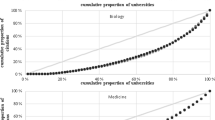Abstract
A thermodynamic analogy allows bibliometric research assessment of information production processes to be based on a scalar indicator which is an energy-like term called exergy. Derived from standard indicators like impact, citations and number of papers, the exergy indicator X is a multiplicative product of quality and quantity of a scientist’s or group’s performance using available bibliometric information. Thus, given the bibliometric sequences of leading research agencies and institutions, research performance can be displayed as trajectories on a two-dimensional map as time progresses. In this paper, we track the performance of several of the leading players contributing to academic scientific research in India.



Similar content being viewed by others
References
Bornmann, L. (2010). Towards an ideal method of measuring research performance: Some comments to the Opthof and Leydesdorff (2010) paper. Journal of Informetrics, 4(3), 441–443.
Bornmann, L., & Mutz, R. (2011). Further steps towards an ideal method of measuring citation performance: The avoidance of citation (ratio) averages in field-normalization. Journal of Informetrics, 5(1), 228–230.
Hirsch, J. E. (2005). An index to quantify an individual’s scientific research output. Proceedings of the National Academy of Sciences of the USA, 102, 16569–16572.
Leydesdorff, L., Bornmann, L., Mutz, R., & Opthof, T. (2011). Turning the tables in citation analysis one more time: Principles for comparing sets of documents. Journal of the American Society for Information Science and Technology, 62(7), 1370–1381.
Prathap, G. (2010a). National academy contribution to national science: An iCE map representation. Current Science, 98, 995–996.
Prathap, G. (2010b). Is there a place for a mock h-index? Scientometrics, 84, 153–165.
Prathap, G. (2011a). The energy–exergy–entropy (or EEE) sequences in bibliometric assessment. Scientometrics, 87, 515–524.
Prathap, G. (2011b). Quasity, when quantity has a quality all of its own—toward a theory of performance. Scientometrics, 88, 555–562.
Prathap, G. (2011c). The quality–quantity–quasity and energy–exergy–entropy exegesis of expected value calculation of citation performance. Scientometrics. doi:10.1007/s11192-011-0516-5.
van Noorden, R. (2010). Building the best cities for science. Nature, 467, 906–908.
Author information
Authors and Affiliations
Corresponding author
Rights and permissions
About this article
Cite this article
Nishy, P., Panwar, Y., Prasad, S. et al. An impact-citations-exergy (iCX) trajectory analysis of leading research institutions in India. Scientometrics 91, 245–251 (2012). https://doi.org/10.1007/s11192-011-0594-4
Received:
Published:
Issue Date:
DOI: https://doi.org/10.1007/s11192-011-0594-4




